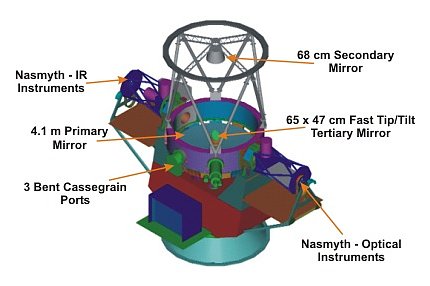SOAR subsystems

The Enclosure
- Achieves precise heat control by means of forced ventilation through a small dome area, set above a small building.
- Unusually enclosed design promotes highly accurate telescope tracking through its control of wind buffeting.
- The building was designed in the US and constructed by local Chilean contractors.
- The dome was built in Brazil, using fiberglass panels from a US firm.
The Mount and Drives
- Built by Vertex-RSI Corp. in Texas
- Uses rolling element bearings for both altitude and azimuth
- Achieves very high pointing and tracking specs
- < 2 arcsec rms blind pointing
- < 0.2 arcsec rms offsetting error
- < 0.2 arcsec rms tracking jitter
- Pre-assembled and tested in factory
- Thoroughly tested in its dome on Cerro Pachon before arrival of the optics system. Throughout 2002, a 10-inch telescope mounted on the side of the main telescope was used to debug and verify pointing and tracking.
4.1m primary mirror
- Very high optical quality: 17 nm rms surface.
- Low thermal mass
- Primary mirror is 4 inches thick
Active optics system
- 120-actuator control of primary
- Secondary on active hexapod
- Image analyzer permanently mounted at one instrument port.
Tip-tilt tertiary mirror
- Rapid tip-tilt correction at all foci
Features
- Many instruments are permanently mounted
- 2 Nasmyth clusters, 3 instruments each
- 2 Folded-cassegrain foci
- Rapid selection between instruments
- 60 seconds to switch
- At least two instruments are always ready.
SOAR Instruments

Goodman Spectrograph
- High-throughput optical spectrograph
- High sensitivity in near-UV down to atmospheric cutoff
- Built by the University of North Carolina, Chapel Hill (PI: Chris Clemens)
- Detectors: two UV-optimized 2K×4K MIT/Lincoln Lab CCDs
- High-throughput Volume-Phase Holographic (VPH) gratings
- Up to R = 1400
- Choice of long slit or aperture plate.
- Designed for rapid readout mode for monitoring short-period variability.
Spartan Infrared Camera
- Near-IR imager combining wide field with high angular resolution
- Built by Michigan State University (PI: Ed Loh) with substantial participation from Brazil
- Initially two 2048x2048 HgCdTe detectors.
- Two more detectors were added in 2005 for 4096×4096 pixels total
- 1–2.5 micron sensitivity
- 2 magnifications
- 3×3 arcmin2 FOV with 0.043 arcsec pixels
- Matched to SOAR's K-band diffraction limit
- 5×5 arcmin2 FOV with 0.073 arcsec pixels
Optical Imager
- SOAR's first-light instrument
- Built by CTIO (NOAO), PI: Alistair Walker
- 2×2048×4096 E2V CCDs
- 15 micron pixels
- Atmospheric dispersion corrector.
OSIRIS IR Spectrometer/Imager
- Near-IR imaging spectrograph built by Ohio State University (PI: Darren Depoy)
- On loan to NOAO
- 1024×1024 HgCdTe array sensitive between 0.95 and 2.4 microns
- Intended as SOAR's IR spectrometer
- Spectroscopy in J, H or K with R = 1200, 3000
- Cross-dispersed mode covering IJHK simultaneously at R ~ 1200
- Also provides imaging with large (0.14 or 0.35 arcsec) pixels over 1.3 or 3.3 arcmin FOV
- Is being slightly modified for use on SOAR (installing narrower slit)
IFU Spectrograph
- Integral-Field, bench-mounted optical spectrometer
- Built by University of Sao Paulo, Brazil (PI: Jacques Lepine)
- Integral-field unit (IFU) fed from a pickoff mirror near telescope focus
- Three interchangeable angular scales via interchangeable fore-optics in telescope focal plane
- Lenslets in 30×50 grid
- Coupled by a 5m-long optical fiber to spectrometer mounted on telescope azimuth structure
- Detector: two red-optimized 2K×4K MIT/Lincoln Lab CCDs
- Roughly 3 CCD pixels/fiber
- R = 1000–40,000

